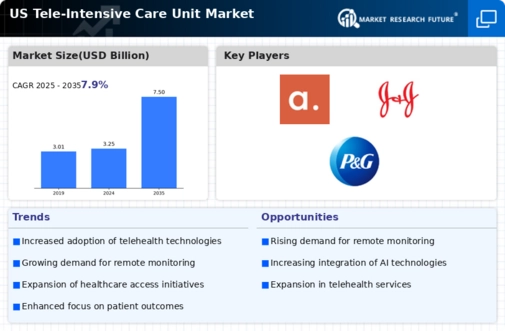Focus on Patient-Centric Care Models
The shift towards patient-centric care models is driving the tele intensive-care-unit market as healthcare systems prioritize personalized treatment and patient engagement. This approach emphasizes the importance of tailoring care to individual patient needs, which aligns well with the capabilities of telemedicine. By leveraging tele intensive-care-unit solutions, healthcare providers can offer more flexible and responsive care options, enhancing the overall patient experience. Data suggests that patient satisfaction scores improve significantly with the use of telehealth services, indicating a positive reception among users. As healthcare organizations increasingly adopt patient-centric strategies, the tele intensive-care-unit market is likely to expand, driven by the demand for solutions that facilitate personalized care and foster stronger patient-provider relationships.
Rising Prevalence of Chronic Diseases
The increasing prevalence of chronic diseases in the US is a notable driver for the tele intensive-care-unit market. Conditions such as diabetes, heart disease, and respiratory disorders necessitate continuous monitoring and specialized care. As the population ages, the demand for intensive care services rises, leading to a greater reliance on telemedicine solutions. According to recent data, chronic diseases account for approximately 70% of all deaths in the US, highlighting the urgent need for effective management strategies. tele intensive-care-unit solutions provide healthcare professionals with the tools to monitor patients remotely, ensuring timely interventions and reducing hospital readmissions. This shift towards remote care is expected to enhance patient outcomes while alleviating the burden on healthcare facilities, thereby propelling the growth of the tele intensive-care-unit market.
Cost Efficiency in Healthcare Delivery
Cost efficiency is a critical factor driving the tele intensive-care-unit market. Healthcare providers are increasingly seeking ways to reduce operational costs while maintaining high-quality care. Tele intensive-care-unit solutions offer a viable alternative by minimizing the need for physical infrastructure and enabling remote patient monitoring. Studies indicate that telemedicine can reduce hospital costs by up to 30%, making it an attractive option for healthcare systems facing financial constraints. Furthermore, the ability to provide care remotely can lead to shorter hospital stays and decreased readmission rates, further contributing to cost savings. As healthcare organizations strive to optimize their resources, the tele intensive-care-unit market is likely to experience significant growth, driven by the demand for more efficient care delivery models.
Integration of Artificial Intelligence
The integration of artificial intelligence (AI) into healthcare is emerging as a transformative driver for the tele intensive-care-unit market. AI technologies enhance the capabilities of telemedicine by enabling predictive analytics, real-time monitoring, and personalized treatment plans. These advancements allow healthcare providers to make informed decisions based on comprehensive data analysis, improving patient outcomes. The tele intensive-care-unit market is witnessing an influx of AI-driven solutions that facilitate remote diagnostics and patient management. As AI continues to evolve, its application in telemedicine is expected to expand, potentially increasing the efficiency and effectiveness of intensive care services. This trend suggests that the tele intensive-care-unit market will benefit from the growing adoption of AI technologies, which may redefine the standards of care in the coming years.
Growing Acceptance of Telehealth Services
The growing acceptance of telehealth services among patients and healthcare providers is a significant driver for the tele intensive-care-unit market. As more individuals become familiar with telemedicine, the demand for remote care solutions is likely to increase. Surveys indicate that approximately 75% of patients are open to using telehealth for follow-up appointments and consultations, reflecting a shift in attitudes towards remote healthcare. This acceptance is further supported by healthcare providers who recognize the benefits of telemedicine in enhancing patient access and convenience. The tele intensive-care-unit market stands to gain from this trend, as healthcare systems integrate telehealth into their service offerings. The increasing willingness to embrace telehealth may lead to a more robust market landscape, characterized by innovative solutions and improved patient engagement.














Leave a Comment